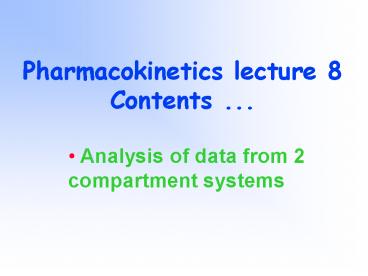Pharmacokinetics lecture 8 Contents ... - PowerPoint PPT Presentation
1 / 21
Title:
Pharmacokinetics lecture 8 Contents ...
Description:
In fact, we use: Cl = K.V1 = 0.303 h-1 x 13.1 L = 3.97 L.h-1. What you should be. able to do ... log graph to extract the two exponentials and hence obtain A, B, ... – PowerPoint PPT presentation
Number of Views:81
Avg rating:3.0/5.0
Title: Pharmacokinetics lecture 8 Contents ...
1
Pharmacokinetics lecture 8Contents ...
- Analysis of data from 2
- compartment systems
2
One compartment -one exponential
Two compartments -two exponentials
Conc
a
a
Log scale
Log scale
b
Time
Time
Conc a
Conc a b
3
Two compartments
4
Two compartments
1mg drug injected i.v. at time zero
5
100 50 30 10 5 3 1
Obvious curvature demonstrates that this is a two
compartment system.
Conc (µg/L)
0 4 8 12 16 20 24
Time (h)
6
100 50 30 10 5 3 1
Identify the terminal linear portion. (A
series of at least three points at the end of the
graph that form a straight line.) Fit line and
extrapolate back to time zero. Read off B and t
½ b
B 9.3 µg/L
Conc (µg/L)
t ½ b 12.5h
0 4 8 12 16 20 24
Time (h)
7
100 50 30 10 5 3 1
Read off values on b ?exponential at 1,2,4 hours
etc.
Conc (µg/L)
0 4 8 12 16 20 24
Time (h)
8
Two compartments
1mg drug injected i.v. at time zero
9
Remember that at any given time point, drug
concentration is equal to the sum of the values
on the two exponentials. We now know the
concentrations and the values on one of the
exponentials, so we can calculate what the value
must be on the other exponential. Conc value
on ? value on ? Value on ? Conc - value on ?
10
Two compartments
1mg drug injected i.v. at time zero
11
A 67.0 µg/L
100 50 30 10 5 3 1
Plot the a values back onto the graph (
). (Value at 6h is too low to plot and is likely
to be very inaccurate.) Fit line and extrapolate
back to time zero. Read off A and t ½ a .
Conc (µg/L)
t ½ a 0.87h
0 4 8 12 16 20 24
Time (h)
12
Convert the half-life of each exponential into
the associated rate-constant
?????????????t ½? 0.693 / 0.87 h 0.80
h-1
?????????????t ½ ? 0.693 / 12.5 h
0.055 h-1
13
Main kinetic values
We now know that ...
A 67.0 ?g/L B 9.3 ?g/L ????0.797 h-1
????0.0554 h-1
From these 4 values, we can calculate all the
usual parameters like K, Cl etc. The equations
appear quite arbitrary and mind-numbingly boring,
but are simple to apply, so long as you are
careful!!!
14
Remember equations? No!
All of the equations used for the analysis of 2
compartment systems are in the module hand-book
and will be provided in any subsequent exam.
15
C0 and AUC
C0 A B 67.0 9.3 ?g/L 76.3
?g/L AUC A/? B/? 67.0 ?g/L /
0.797 h-1 9.3 ?g/L / 0.0554 h-1
84.1 167.9 ?g.h.L-1 252.0 ?g.h.L-1
16
Elimination rate constantK
K C0 / AUC 76.3 ?g/L / 252.0 ?g.h.L-1
0.303 h-1
17
Transfer constantsk12 k21
k21 ??? K 0.80 x 0.055 h-1
0.303 0.145 h-1 k12 ?
? - k21 - K 0.80 0.055 - 0.145 -
0.303 h-1 0.407 h-1
18
Volumes of distributionV1, V2 Vss
V1 D/C0 1000 ?g / 76.3 ?g/L
13.1 L Vss k12 k21 . V1 k21
0.407 0.145 h-1 . 13.1 L
0.145 h-1 49.9 L
19
Volumes of distributioncontinued ...
Vss V1 V2 (Rearrange ...) V2 Vss - V1
49.9 - 13.1 L 36.8 L
20
Clearance (Cl)
Remember that the equation we have used
previously Cl K.V is now inadequate. We
need to define which volume. In fact, we use Cl
K.V1 0.303 h-1 x 13.1 L 3.97
L.h-1
21
What you should be able to do
- Identify whether a drug occupies one or two
compartments from the shape of the graph of log
concentration versus time - Use a semi-log graph to extract the two
exponentials and hence obtain A, B, ? ?? - Use the appropriate equations to obtain K, V1,
V2, Clearance etc. from A, B, ? ???































